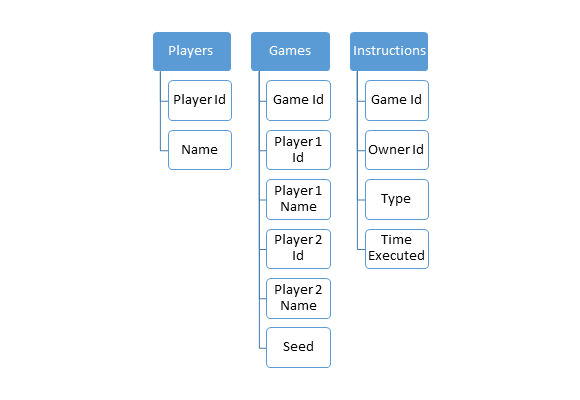Last time we looked at how you could persist your game data using Azure Mobile Services. Because Azure Mobile Services is a NoSQL data store I recommended that you denormalize your data in order to reduce the number of requests needed to fetch things on the client. All well and good, but this decision has a consequence. Namely, how do you keep the duplicated data up to date?
Before continuing, have a look at the data on the server. Notice that we’ve duplicated the players’ names into the games table. This allows you to fetch all the needed information for a game in a single query, but if the a player updates her name the games table will be out of date.

So how do you keep your data consistent? For Scramble Legends I evaluated three options:
- Run a CRON job or worker thread on the server. Have it test for inconsistencies and fix them
- Test for inconsistency on the client or server and update accordingly
- Update the game data when updating the player data
Fix Inconsistency over Time
The first option I considered was to create a second process responsible for dealing with inconsistencies – be it a CRON script, a worker thread, or a queue containing a list of objects to update. Azure Mobile Services makes it relatively easy to write CRON scripts using JavaScript and the rest of Azure has the tools necessary to do more complex stuff using C#.
For write-heavy games this solution is very practical. The writes won’t carry any extra overhead trying to keep things consistent, and you can always add more CRON jobs or worker threads as your workload grows. As long as your game can deal with a little inconsistency, e.g. the player’s name being out of date before the CRON script has run, then there’s a lot to like.
With all that said I opted against this approach for Scramble Legends. While I think using a queue and worker thread to track and propagate changes makes sense for busier applications I wanted to avoid the cost and overhead associated with developing and running them. In reality this approach will require you to write more and more error-prone code, so I would save it for later when you have proven your game needs the extra performance.
Fix Inconsistency on Read
Next I considered detecting inconsistencies when reading game data and updating the game table as necessary. Honestly, this is a terrible solution. In practice it would require querying the player table every time the game data is read – the entire reason we denormalized the data was to avoid this query! Furthermore, in the event of an inconsistency three queries would need to be made: one to load the game data, one to load the player data, and one to update the game data. Each new query increases the likelihood for something to go wrong. The goal is to reduce the chances for failure and the number of queries as much as possible, so this option is a non-starter.
Fix Inconsistency when Updating the Player
Despite its drawbacks the last option got me thinking: if fixing things on read is too expensive what about on write? Using Azure Mobile Services it’s possible to write a script which runs whenever the player data is updated. At that point it’s very likely the player’s game data will become inconsistent, so why not proactively update it? For Scramble Legends this is the approach I took. What’s more you can have the script return control to the client as soon as the player is updated and then update the player’s games without blocking the UI:
function update(item, user, request) {
var gamesTable = tables.getTable('GameData');
request.execute({
success: function(result) {
// Asychronously update games the player is part of
gamesTable.where(function(player)
{
return this.OwnerId == player.PlayerId ||
this.OpponentId == player.PlayerId
}, item)
.read({
success: function(games) {
games.forEach(function(game) {
if (game.OwnerId == item.PlayerId) {
game.OwnerName = item.Name;
game.OwnerAvatar = item.AvatarType;
} else {
game.OpponentName = item.Name;
game.OpponentAvatar = item.AvatarType;
}
gamesTable.update(game);
});
}
});
// Respond to the player immediately so the UI isn't blocked
request.respond();
}
});
}
Wrapping Up
There are a number of ways to keep your game’s data consistent. Which one is best depends on the profile of your game. In my opinion it’s safe to start with the simpler, less optimized approach I took for Scramble Legends and then upgrade to a more robust, scalable solution when you have proven there’s a market for your game.
Source code for the example in this post.
- Writing a Windows 8 Game Loop: Explores three ways to create a game loop
- XAML or MonoGame?: Examines the pros and cons for each option
- Storing Game Data in the Cloud: Azure Mobile Services or Cloud Storage?
- Animating Sprites with XAML: Cover the basics of animation for Windows 8
- Animating Spritesheets with XAML: Learn how to render a spritesheet using XAML and C#
- Persisting Game Data in Practice: One way to do it and some common pitfalls
- Keeping Game Data Consistent: How to maintain consistency in a NoSQL world

